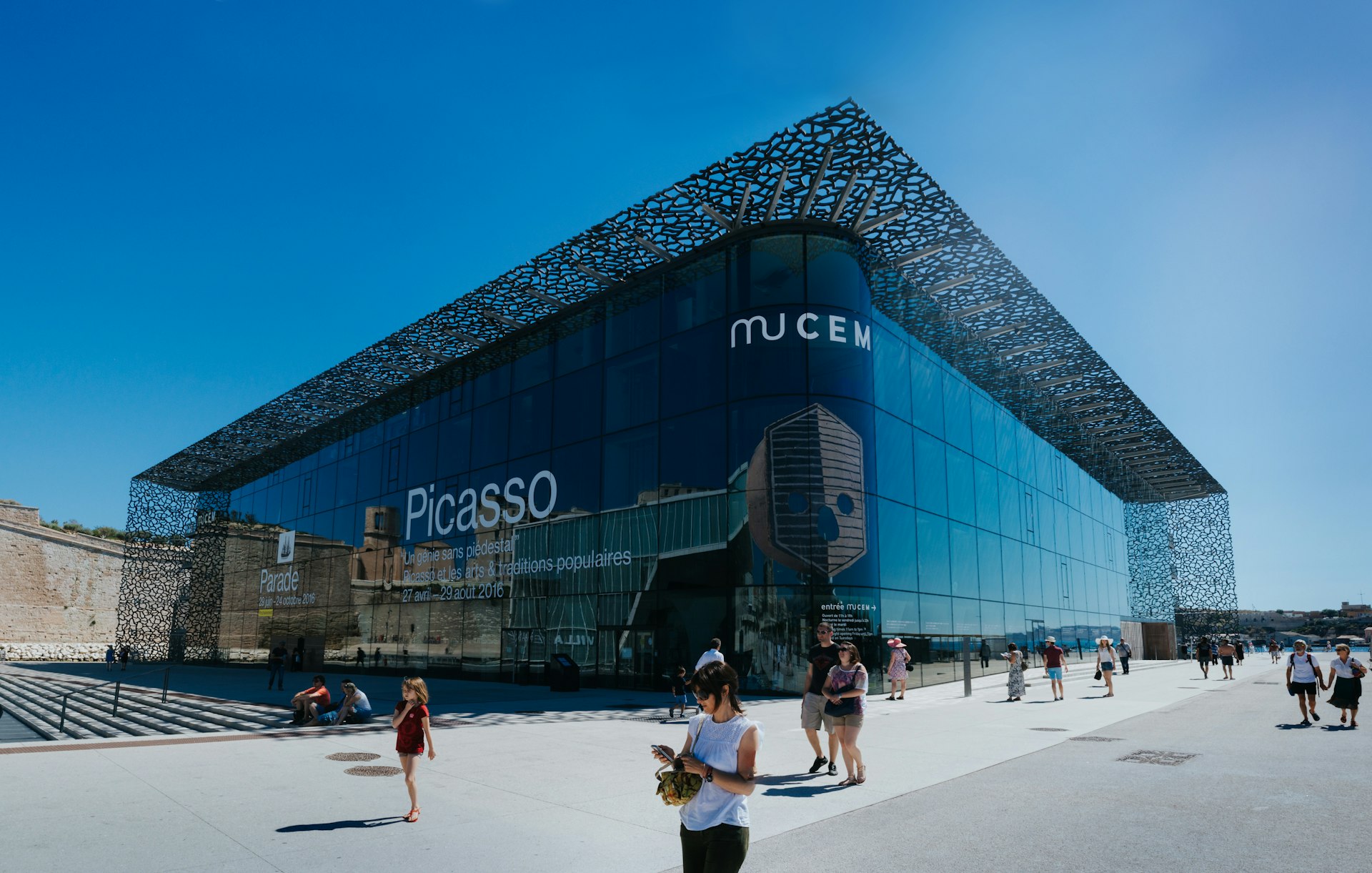As ancient Greek port, traditional rebel and contemporary French starlet, the beguiling city of Marseille has a hypnotic mashup of urban grit and grandeur – the rough-cut diamond on a coastline bejeweled with tranquil fishing villages and natural beauty spots. The good news is, its museum offering is equally bold and eclectic.
In keeping with the city’s socialist spirit, several musées are free and take visitors to less-explored neighborhoods where Marseille’s working-class heart beats loud and clear. At municipal-run museums, you only pay to view temporary exhibitions (except on the first Sunday of each month): permanent collections are free year-round.
Watch for some brilliant new openings: a replica of the world-famous Grotte Cosquer with its rare paleolithic cave art opened at the seafront Villa Méditerranée in June 2022, and 2023 ushers in a museum celebrating Marseille’s unmatched maritime heritage.
1. Musée d’Histoire Marseille
Best for history buffs
The history of Marseille is the focus of this thoughtful museum. From its birth as Greek around 600 BCE to deadly plague, the coining of France’s national anthem La Marseillaise in the 18th century and mass immigration from Algeria in the 1950s, the action-packed drama that unfolds in 12 interactive exhibits is enthralling. Archaeological relics from ancient Massilia, uncovered on site during building work, add to the museum’s authenticity.

2. MuCEM
Best for striking architecture and sea views
Contemporary Marseille’s Musée des Civilisations d’Europe et de la Méditerranée is as much about sharp architecture and sassy sea views as world-class exhibits delving into the curious tales behind European and Mediterranean civilizations. Neolithic and contemporary art, football, graffiti, antique tarot cards, 80,000 sound recordings, the 1970s habit of queer nun Sister Orgia decorated with the colors of Marseille football club, mermaid-shaped bread: the diverse collection is vast, eclectic and relentlessly surprising.
Exploring the "secret" walkways tucked between the glass façade of Rudy Ricciotti’s stunning cube-shaped building and outer fishnet-inspired latticework cladding is a highlight. Wind up the external ramp to the rooftop for a sensational ocean panorama. Later, cross the footbridge to Fort St-Jean to leap from modern architectural sass to 13th-century military design. Don’t miss MuCEM after dark when a lighting installation by artist Yann Kersalé bathes the ensemble in deep sea blue.
3. Orange Vélodrome
Best for soccer fans
Orange Vélodrome is one of France’s most revered sports stadiums and gig venues to see international bands. But for passionate sports fans eager to delve into the wings of Olympique de Marseille’s hallowed home ground and 2023 Rugby World Cup final venue, a tour is Marseille’s star museum turn.
Tours set up by Marseille tourist office take you backstage into the 67,000-seater stadium, built as a cycling track in 1937 and rebuilt with a recyclable rainwater roof system for the 1998 football World Cup. Self-guided tours take you onto the pitch, into the players’ changing rooms and around an exhibition dedicated to the history of Marseille’s iconic OM football club who have played here since the 1930s. Consider a meal afterwards at market-driven Signature, a 10-minute walk away in the same less-visited, residential neighborhood.
4. MauMA
Best for emerging street art
Until 2026, watch for new murals and frescoes by French and international artists on public building facades in less explored neighborhoods around the port and northern Marseille as part of the edgy Musée des Arts Urbains à Marseille (MauMA; Urban Arts Museum).
Pick up the open-air trail in the 2e and 3e arrondissements, and later 14e and 15e. The inaugural portrait of Uyghur refugee Tursunay Ziawudun by Marseille-based Parisian artist Mahn Kloix at 93 rue Félix Pyat, 3e, is worth the urban trek. On the same street, look for a brilliant 40m-tall (131ft) Pissenlit (Dandelion) by Aurélie Maset clambering up the side of a high-rise apartment block.

5. Palais Longchamp
Best classical art
Everything about this elegant Musée des Beaux Arts is beau (beautiful). Its setting is a colonnaded palace, built in 1869 to celebrate the completion of a 10-year engineering project bringing fresh water from the Durance River, 85km (53 miles) north, to a reservoir on Marseille’s Longchamp plateau via 18 aqueduct bridges. Sculpted lions and tigers guard the palace entrance and paintings, drawings and sculptures from the 17th and 18th centuries fill its left wing.
Post-museum, enjoy a walk in the park. Palais Longchamp’s manicured, fountain-adorned gardens are a soothing green antidote to built-up Marseille.
6. Musée Subaquatique
Best museum to visit with older kids and teens
Art, environmental protection and marine biology meet at Marseille’s most unusual museum – at the bottom of the sea. Accessible from the sandy shore of urban beach Plage des Catalans, museum visits require a snorkel, mask and flippers. Free admission translates as a 100m (328ft) swim from the beach to the underwater museum where an artificial reef of 10 sculptures – a polar bear, giant fish, sea urchin, buddha-styled figure et al, crafted by different international artists from PH-neutral cement – languishes 5m (16ft) deep on the seabed.
Visit in pairs or more – never alone – and check weather conditions before diving in. Or book a guided snorkeling or scuba-diving visit via the museum website. Post-snorkel, chill on the beach while bronzed volleyball players bounce around on court.
7. Mx
Best for curious foodies
If you want to know a momie from a mominette or a perroquet from a mauresque, Mx is the address. Provence’s classic aperitif, pastis, was cooked up in Marseille by industrialist Paul Ricard in 1932 and this hybrid museum-concept store, celebrating the history and culture of the anise-flavored spirit, is a pilgrimage no foodie should miss.
Interactive exhibits whirl visitors through a kaleidoscope of sensory experiences based around anise, Marseille’s most important flower, spice and aromatic. Tasting workshops and mixology masterclasses provide ops to drink pastis which, amber-colored in the bottle, turns white when mixed with water. End the 4.0 museum experience over a 51 Swizzle (pastis cocktail mixing plant liqueur, grapefruit juice, lime juice and cinnamon syrup) at the sunflower-yellow Mx Bar.

8. Centre de la Vieille Charité
Best for old-world romantics
Mooching around the historic neighborhood of Le Panier – Marseille’s oldest quartier – is a mellow experience. Its steep, golden-hued stone streets and dusty squares are a living museum in their own right, and its centerpiece 17th-century almshouse is home to two excellent museums dedicated to African, American and Pacific arts and Mediterranean archaeology. The latter displays France’s largest Egyptian collection after the Louvre in Paris. Both museums are free.
Afterwards browse the neighborhood’s scattering of artist studios and artisan boutiques for olive oil, buttery biscuits, traditional Marseillais santons (nail-sized Christmas creche figurines) and a rainbow of handmade scented soaps.
9. Musée Cantini
Best for modern art
One of Marseille’s best art museums, this recently renovated house museum languishes in the elegant hôtel particulier where sculptor Jules Cantini lived and worked until his death in 1916. The mansion was built in 1694 for the Compagnie du Cap Nègre, a company that fished for coral along Tunisia’s northern coastline and – as was so typical of Marseille at the time – traded in leather, wool and wax.
Jules Cantini was an avid art collector as well as artist, and the private art collection he bequeathed to the city is sensational. Covering the period from around 1900 to 1960, all the modern greats are well represented: the Fauvists, early Cubists, Surrealists and so on, all of whom were lured to Provence for its extraordinary warmth and light.














